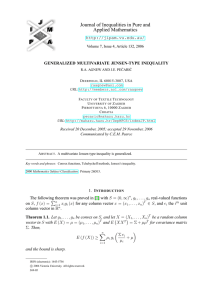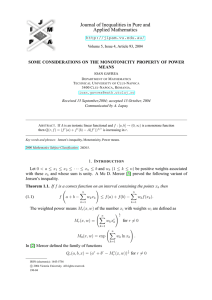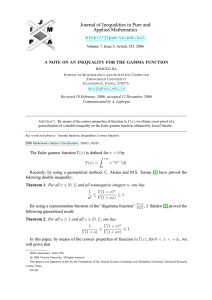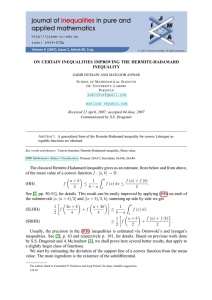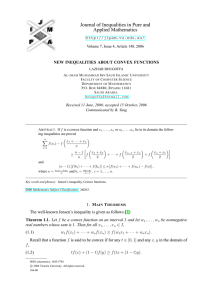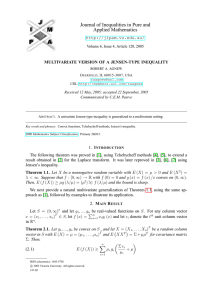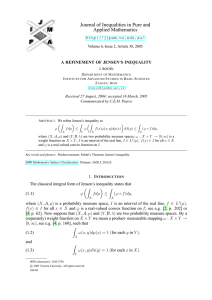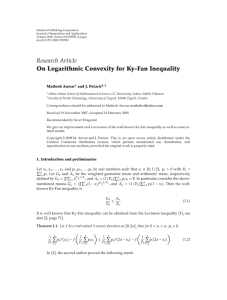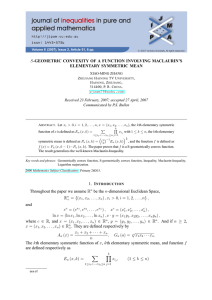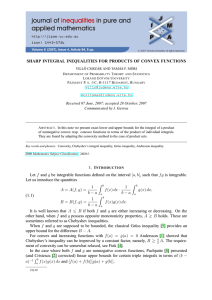ON A GENERALIZATION OF THE HERMITE-HADAMARD INEQUALITY II
advertisement
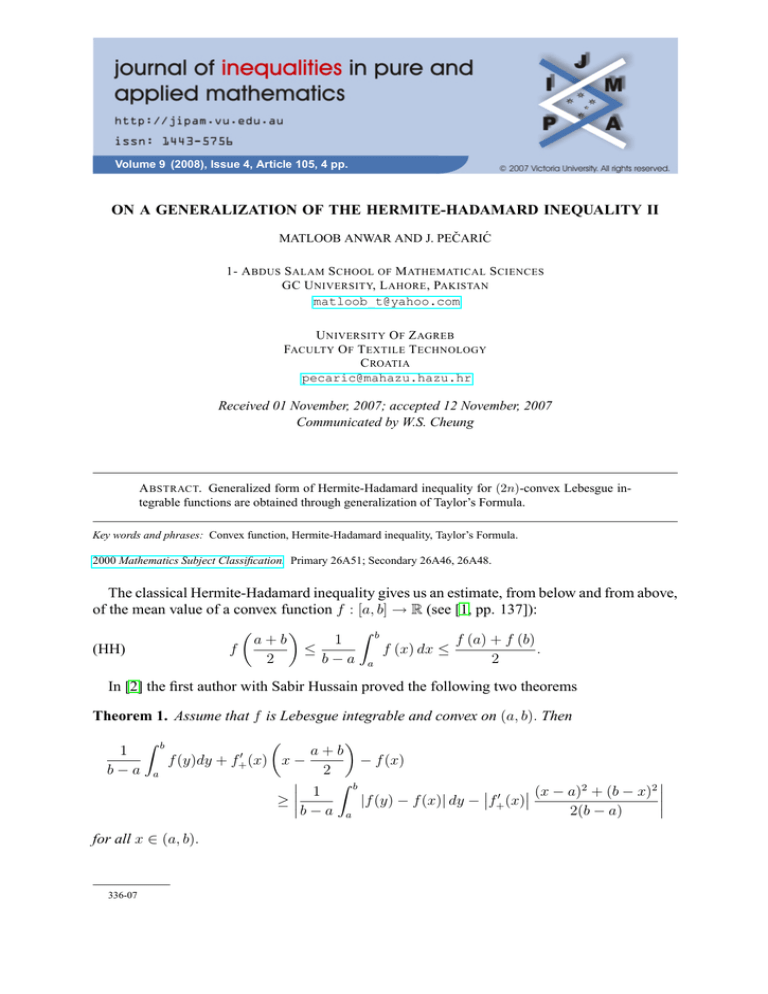
Volume 9 (2008), Issue 4, Article 105, 4 pp. ON A GENERALIZATION OF THE HERMITE-HADAMARD INEQUALITY II MATLOOB ANWAR AND J. PEČARIĆ 1- A BDUS S ALAM S CHOOL OF M ATHEMATICAL S CIENCES GC U NIVERSITY, L AHORE , PAKISTAN matloob_t@yahoo.com U NIVERSITY O F Z AGREB FACULTY O F T EXTILE T ECHNOLOGY C ROATIA pecaric@mahazu.hazu.hr Received 01 November, 2007; accepted 12 November, 2007 Communicated by W.S. Cheung A BSTRACT. Generalized form of Hermite-Hadamard inequality for (2n)-convex Lebesgue integrable functions are obtained through generalization of Taylor’s Formula. Key words and phrases: Convex function, Hermite-Hadamard inequality, Taylor’s Formula. 2000 Mathematics Subject Classification. Primary 26A51; Secondary 26A46, 26A48. The classical Hermite-Hadamard inequality gives us an estimate, from below and from above, of the mean value of a convex function f : [a, b] → R (see [1, pp. 137]): Z b a+b 1 f (a) + f (b) (HH) f ≤ f (x) dx ≤ . 2 b−a a 2 In [2] the first author with Sabir Hussain proved the following two theorems Theorem 1. Assume that f is Lebesgue integrable and convex on (a, b). Then 1 b−a Z b f (y)dy + a for all x ∈ (a, b). 336-07 f+0 (x) a+b x− − f (x) 2 Z b 1 0 (x − a)2 + (b − x)2 ≥ |f (y) − f (x)| dy − f+ (x) b−a a 2(b − a) 2 M ATLOOB A NWAR AND J. P E ČARI Ć Theorem 2. Assume that f : [a, b] → R is a convex function. Then Z b 1 f (b)(b − x) + f (a)(x − a) 1 f (x) + − f (y)dy 2 b−a b−a a Z b Z b 1 1 1 0 ≥ |f (x) − f (y)| dy − |x − y| |f (y)| dy 2 b−a a b−a a for all x ∈ (a, b). Remark 1. For x = a+b in Theorem 1 and x = a or x = b in Theorem 2, we obtain improve2 ments of inequality (HH). In this paper we will prove further generalizations of these results. Theorem 3. Assume that f : [a, b] → R is a (2n − 1)-times differentiable and (2n)−convex function. Then 1 (b − a) Z b (b − x)k+1 − (a − x)k+1 (k) f (x) (k + 1)!(b − a) 1 2n−2 1 Z b X (y − x)k (k) ≥ f (x) dy f (y) − f (x) − (b − a) a k! 1 (2n−1) (b − x)2n − (a − x)2n − f (x) (2n)!(b − a) f (y)dy − (b − a)f (x) − a 2n−1 X for all x ∈ (a, b). Proof. It is well known that a continuous (2n)−convex function can be uniformly approximated by a (2n)−convex polynomial. So we can suppose that we have (2n)−derivatives of f . By Taylor’s formula, f (y) = f (x) + (y − x)f 0 (x) + (y − x)2 00 f (x) + · · · 2! (y − x)2n−1 (2n−1) (y − x)2n (2n) + f (x) + f (ξ), 2n − 1! 2n! for x, y ∈ [a, b], ξ ∈ (a, b). Since f is (2n)−convex, we have f (2n) (x) ≥ 0. So (y − x)2 00 (y − x)2n−1 (2n−1) f (y) ≥ f (x) + (y − x)f 0 (x) + f (x) + · · · + f (x) 2! (2n − 1)! and we can write f (y) − f (x) − (y − x)f 0 (x) − (y − x)2 00 (y − x)2n−1 (2n−1) f (x) − · · · − f (x) ≥ 0, 2! 2n − 1! i.e., (y − x)2 00 (y − x)2n−1 (2n−1) f (y) − f (x) − (y − x)f (x) − f (x) − · · · − f (x) 2! (2n − 1)! (y − x)2 00 (y − x)2n−1 (2n−1) 0 = f (y) − f (x) − (y − x)f (x) − f (x) − · · · − f (x) . 2! (2n − 1)! 0 J. Inequal. Pure and Appl. Math., 9(4) (2008), Art. 105, 4 pp. http://jipam.vu.edu.au/ H ERMITE -H ADAMARD I NEQUALITY 3 Now by using the triangle inequality (y − x)2 00 (y − x)2n−1 (2n−1) (1) f (y) − f (x) − (y − x)f (x) − f (x) − · · · − f (x) 2! 2n − 1! (y − x)2n−2 (2n−2) ≥ f (y) − f (x) − (y − x)f 0 (x) − · · · − f (x) 2n − 2! (y − x)2n−1 (2n−1) − f (x) . 2n − 1! 0 Now integrating the last inequality with respect to y and using the triangle inequality for integrals, we get b 2n−1 X (b − x)k+1 − (a − x)k+1 (k) f (x) (k + 1)! a 1 Z 2n−2 b 2n 2n X (y − x)k (b − x) − (a − x) . ≥ f (k) (x) dy − f (2n−1) (x) f (y) − f (x) − a k! (2n)! Z f (y)dy − (b − a)f (x) − 1 Theorem 4. Assume that f : [a, b] → R is a (2n − 1)−times differentiable and (2n)−convex function. Then 2n f (x) − (b − a) b 2n−1 X 2n − k [(x − b)k f (k−1) (b) − (x − a)k f (k−1) (a)] k!(b − a) a 1 2n−2 1 Z b k X (x − y) (k) f (y) dy ≥ f (x) − f (y) − b − a a k! 1 Z b (x − y)2n−1 (2n−1) 1 − f (y) dy . b − a a (2n − 1)! Z f (y)dy − Proof. Integrating (1) with respect to x and by using the triangle inequality for integrals, we get b b 2n−1 X (y − x)k (k) f (x)dx k! a a 1 Z Z b 2n−2 b k 2n−1 X (y − x) (k) (2n−1) (y − x) dx . ≥ f (x) dx − f (x) f (y) − f (x) − (2n − 1)! a k! a 1 Z (2) (b − a)f (y) − Z f (x)dx − By replacing x and y we obtain the required result. Corollary 5. Suppose that f : [a, b] → R is a (2n − 1)−times differentiable and (2n)−convex function. Then 1 (b − a) Z b f (y)dy − (b − a)f a a+b 2 J. Inequal. Pure and Appl. Math., 9(4) (2008), Art. 105, 4 pp. − 2n−1 X 1 b−a k+1 2 k+1 − a−b a+b (k) 2 f (k + 1)!(b − a) 2 http://jipam.vu.edu.au/ 4 M ATLOOB A NWAR AND J. P E ČARI Ć 2n−2 1 Z b X y − a+b k a+b a + b 2 ≥ − f (k) f (y) − f dy (b − a) a 2 k! 2 1 (2n−1) a + b (b − a)2n − (a − b)2n . − f 2 (2n)!(b − a)22n Proof. Set x = a+b 2 in Theorem 3. Corollary 6. Suppose that f : [a, b] → R is a (2n − 1)−times differentiable and (2n)−convex function. Then Z b 2n−1 X 2n − k 2n f (a) − f (y)dy − [(a − b)k f (k−1) (b)] (b − a) a k!(b − a) 1 2n−2 1 Z b X (a − y)k (k) ≥ f (y) dy f (a) − f (y) − b − a a k! 1 Z b (a − y)2n−1 (2n−1) 1 f (y) dy . − b − a a (2n − 1)! Proof. Set x = a in Theorem 4. R EFERENCES [1] J.E. PEČARIĆ, F. PROSCHAN AND Y.C. TONG, Convex Functions, Partial Orderings and Statistical Applications, Academic Press, New York, 1992. [2] S. HUSSAIN AND M. ANWAR, On generalization of the Hermite-Hadamard inequality, J. Inequal. Pure and Appl. Math., 8(2) (2007), Art. 60. [ONLINE: http://jipam.vu.edu.au/ article.php?sid=873]. J. Inequal. Pure and Appl. Math., 9(4) (2008), Art. 105, 4 pp. http://jipam.vu.edu.au/
